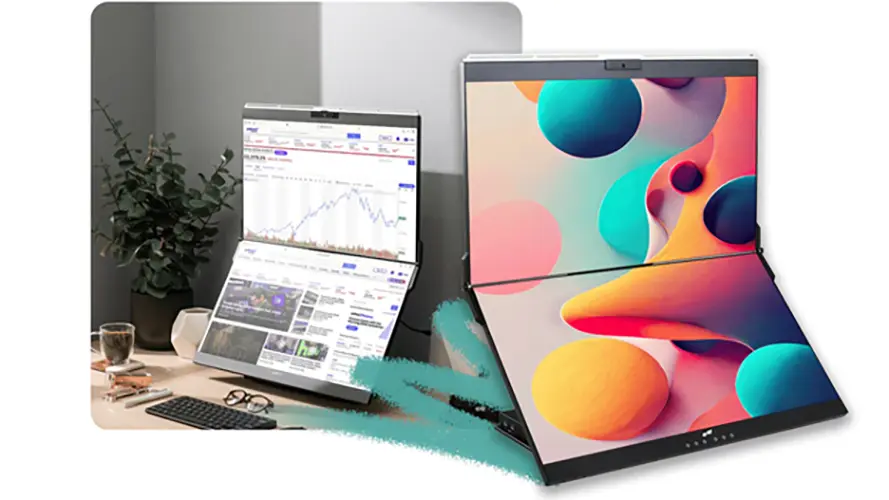Anyone in data science and analytics knows this: you cannot evade copious amounts of information. Whether you are conducting research, penning down your results, working 9 to 5 in an analytics company, or just doing it on the side as a hobby, you will always need efficient data visualization and analysis.
Hence, you’d be faced with more data than you count. On top of this, you may find that the traditional monitors are not as efficient as you need them to be. Here’s a new solution: Stacked monitors! Stacked monitors have proven in many sectors to be effective, productive, and efficient in helping users manage numerous data across a more comprehensive screen estate. On top of this, the vertical setup of the stacked monitors proves more advantageous for data analysts.
The Mobile Pixels Geminos stacked monitors are recommended for your data exploration, collaborative work, and analysis. Keep reading to learn more about how stacked monitors positively influence data science and analysis.

Let’s talk about Stacked Monitors!
There are many definitions for stacked monitors. One of these is: Stacked monitors is that the type of monitor setup that takes up less space on your worktable. While this is 100% true, there’s so much more to the stacked monitor than just a space optimizer. Regarding its physical description, the stacked monitor is a single monitor consisting of more than one display screen (usually two). The double screens are then vertically loaded atop each other in a vertical format. Hence, stacked monitors are taller and narrower than traditional desk computers.
How does the Stacked Monitor affect Data Science and Analytics?
There are five ways the stacked monitor is beneficial to the field of data science and analytics, and we’d be exploring them below:
Data scientists can achieve more on the wider screen
One of the primary advantages of stacked monitors in data science and analytics is the substantial boost in productivity they provide. The expanded screen estate allows analysts to open multiple applications and datasets simultaneously, reducing the need for constant window switching and minimizing distractions. With more screens available, data scientists can keep their code editor, data visualization tools, and statistical packages open concurrently, facilitating a seamless workflow and enabling them to work more efficiently.
Analysts can juggle multiple tasks more efficiently.
To achieve workflow optimization, data analysts need to be able to multitask. It is almost impossible for data analysts to work on a single file simultaneously as some other monitor user. They are jumping from tab to tab or from window to window, trying to compare or contrast two or more pieces of information. That’s why the stacked monitor is significantly advantageous. Analysts can dedicate each monitor to a specific task, such as data cleaning, exploratory analysis, model development, and result visualization. That way, they could smoothly transition between stages of analysis and enable a holistic view of their workflow.
Data is better explored on stacked monitors
Sometimes, data analysts might need help to escape complex datasets. Data scientists would need the best monitor to enhance data visualization and exploration for those complex and comprehensive sets. They’ll need to grasp better the underlying patterns and insights hidden within the data — hence, stacked monitors. The monitors provide data scientists with an immersive and comprehensive visualization experience. Moreover, stacked monitors allow for side-by-side comparisons, enabling analysts to study different visualizations simultaneously and better understand the relationships between variables.
Stacked monitors contribute to seamless collaboration
Collaboration is another essential part of the field, and fortunately, stacked monitors enable efficient information sharing and enhance teamwork. With that said, the next question is: How does it do that? With multiple monitors, data scientists can maintain their primary workspace while accessing shared resources, avoiding the clutter of overlapping windows on a single screen. Stacked monitors also facilitate joint coding sessions, where multiple data scientist programmers can work simultaneously. This will enhance the team’s overall efficiency and foster a collaborative work environment.
Stacked monitors enhance the utilization of computational resources

As you might already know, as data scientists and analysts, data-intensive tasks, such as running complex models, simulations, or processing large datasets, often demand substantial computational power. With stacked monitors, analysts can keep track of their processes in real-time while utilizing additional screens to monitor system performance, log files, or documentation. The setup also allows for efficient resource management, which enables them to identify potential bottlenecks, optimize algorithms, and respond promptly to errors or anomalies during the data analysis pipeline.
Conclusion
There you have it! Stacked monitors can do five things for you right now as a data scientist and analyst. It’s not that the traditional monitors can’t meet your requirements. But when you have more monitor screens, you can get more productive. However, having multiple monitor screens allows you to be more productive. Furthermore, the data coding and exploration, with the collaborative offering and other features, make this monitor the finest alternative for anyone in this profession.





